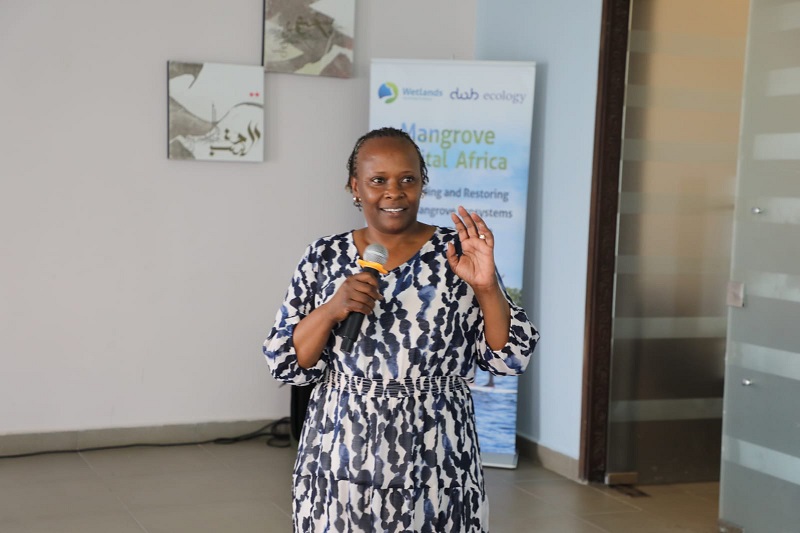
By Ruth Keah – rkeahkadide@gmail.com
Experts are calling for reassessment of approaches being used in mangrove conservation in Kenya in order to achieve maximum benefits.
According to research findings by Wetlands International highlighted by its Director In charge of East Africa Region, Julie Mulonga, mass mangrove planting efforts have proven ineffective since a significant number planted seedlings die.
“We have discovered that for instance, when someone plants 10,000 mangroves, the survival rate is approximately 30 per cent to 32 per cent, a notably low figure,” she said.
The organisation is now promoting natural mangrove restoration where people create suitable conditions in specific areas for the trees to thrive independently. Ms Mulonga acknowledges that while this approach might require more time, the likelihood of achieving a higher survival rate is considerably greater.
Speaking at a training for Kenya Forest Service organized by Wetlands International in collaboration with MAP in Mombasa, However, Mr Mulonga encouraged Mass mangrove planting in locations where creating these conducive conditions was a challenge.
“It is on a case-by-case basis. We emphasize thoroughly understanding your specific area. This entails knowledge about water flow patterns, soil conditions and other relevant factors. By doing so, you can effectively facilitate the natural growth of mangroves,” she said.
Another crucial point emphasised by Ms Mulonga is the active involvement of communities residing in close proximity to mangroves. This inclusive approach, she said, aims at instilling a sense of ownership and foster a deep commitment among the communities towards mangroves conservation.
“It is important to engage the community through an integrated approach that combines restoration efforts with livelihood opportunities. This approach helps the community to gain a profound understanding of the significance of preserving mangroves,” she said. She cited empowering the community with beekeeping and honey harvesting initiatives which ensures that they have vested interest in preserving the mangroves because they understand that cutting down the mangroves would jeopardise the survival of their honey production.
She said Kenya had experienced loss of 1,000ha of mangrove forests over the past two decades. However, she said there was positive news as well with 2016 to 2020 witnessing a notable increase of 500ha mangrove cover across the country.
She attributed the growth in mangrove cover to several factors, including heightened commitment by organisations and government to restore mangroves.
Additionally, a reduction in mangrove harvesting besides increased awareness about the adverse consequences of mangrove cutting has reduced destruction, thereby contributing to the increased mangrove cover.
The rich biodiversity supported by mangrove ecosystems contributes to the overall health and resilience of the environment. These coastal forests provide a unique habitat for a wide array of plant and animal species. Mangrove roots serve as nurseries for juvenile fish, shellfish and other marine organisms contributing to the productivity and sustainability of coastal fisheries.
Preserving biodiversity is essential for safeguarding the overall stability of ecosystems. In Kenya, where coastal communities depend heavily on marine resources for sustenance and livelihoods, protecting mangrove biodiversity is intertwined with climate adaptation and human well-being.
Ms Mulonga expressed her organisation’s commitment to supporting government’s ambitious goal of planting 15 billion trees by 2032, to achieve a 30 per cent tree cover.
Alex Lemarkoko, the Chief Conservator of Forest at the Kenya Forest Service underscored the pivotal role of the mangrove ecosystem. He said mangroves are crucial for coastline protection, contribute significantly to the blue economy and serve as a vital breeding ground for a diverse range of marine species.
However, he said the mangrove ecosystem faces significant threats due to human activities associated with infrastructure development and poverty.
Mr Lemarkoko said in collaboration with various organisations, KFS was actively training its officers in utilisation of modern and emerging technologies.
“All these threats must be addressed and they can only be effectively tackled through collaboration involving key stakeholders such as the Kenya Forest Service, Kenya Marine and Fisheries Research Institute, other research institutions, donor agencies and the local community,” he said.


i wish to receive the post from Wetlands international/ ESHA